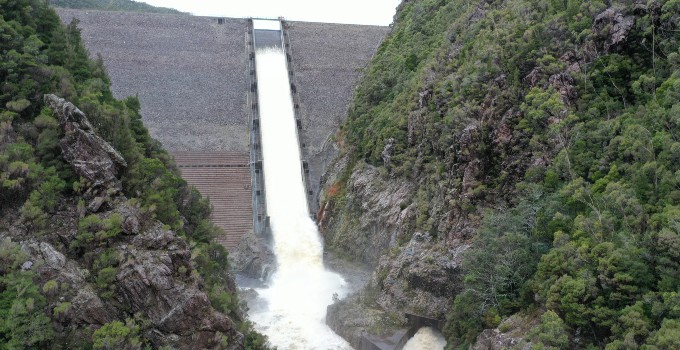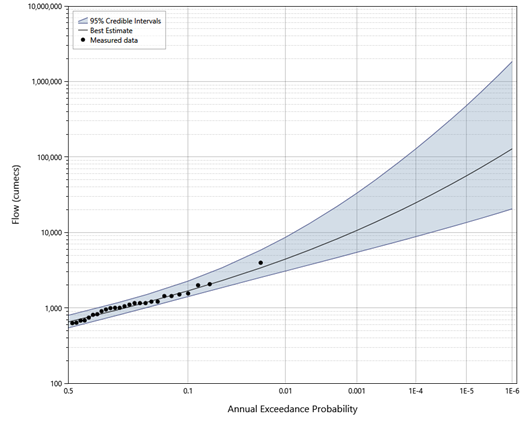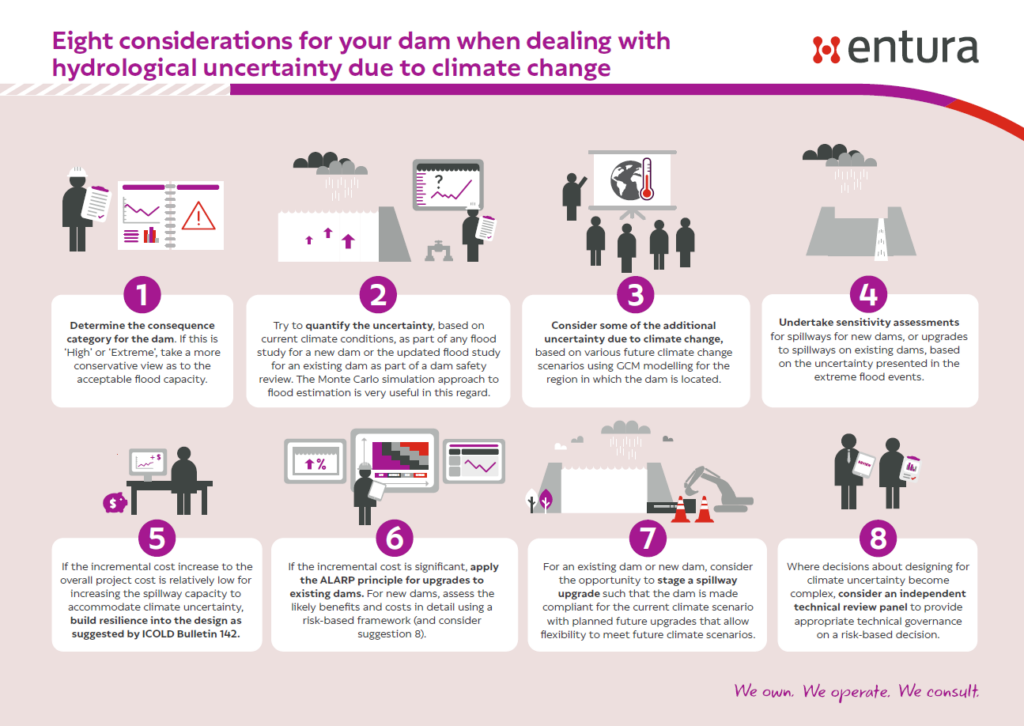THOUGHT LEADERSHIP
Designing dams for an uncertain climate future
Dams are critical infrastructure for water supply, irrigation, energy production, flood protection, or multiple purposes. They are usually designed to last at least 100 years, yet with good maintenance and appropriate dam safety practices, dams can continue to perform as designed for centuries. But what about climate change? The circumstances in which a dam operates may be very different in the coming decades – and exactly how these changes will play out in different regions is impossible to predict with certainty.

Dams are designed to continue to perform safely in extreme events, such as major floods and earthquakes, to avoid the high economic, environmental, and social consequences of dam failure. When the consequence has the potential to be extreme, the flood that the dam will need to be designed for is, in Australia, the ‘Probable Maximum Flood’ (PMF), while in some other parts of the world it is often the 1:10,000 annual exceedance probability (AEP) flood.
But even if standards or guidelines are clear about the ‘return period’ of flood that the dam should be designed for – is it still as simple as reading the magnitude of the flood discharge off the flood frequency curve as has been done in the past? These days, it is not so simple.
Exploring the inherent uncertainty in the flood frequency curve
Part of the reason for more complexity is that we have greater computing power today to be able to explore the uncertainty in our flood frequency curve. Predicting extreme flood events (such as the PMF) is not an exact science and involves many variables which are often not well characterised. As a result, there is significant uncertainty in predicting floods, particularly extreme floods. If this uncertainty is presented, the flood frequency curve is no longer a single line but a band. The more extreme the flood event, the wider the uncertainty band. Although the flood frequency curve shown below is fitted directly to measured flow data, the uncertainty bounds are similar regardless of the approaches implemented to derive the flood frequency curves.

So, what flood should the dam be designed for? Should it be the median best estimate, or should it take into account some of the uncertainty? This is the first challenge, and it is there whether we consider climate change or not.
Adding the extra uncertainty of climate change
Climate change doesn’t stand still. This adds even more complexity to the flood prediction challenge. What is the impact of climate change on extreme events now, and what will it be as time goes by? Numerous studies of climate change impacts suggest that there will be greater variability in extreme temperatures and extreme rainfall, and that extreme events may become more frequent. As a result, the magnitude of extreme flood events, for which dams must be designed, will likely increase with time.
Changes in the magnitude or frequency of extreme floods will depend on projections of future temperature, emission scenarios and the models used to simulate the changes. Even with a ‘middle of the road’ emission scenario (such as the IPCC’s SSP2–4.5 scenario) that results in a median global temperature increase of 3 °C (compared to preindustrial temperature baseline) by the end of this century, there could be a 23% increase in 24-hour extreme rainfall depth. But this is only one of the scenarios; some are more extreme, some show less increase, some show more. The increase is greater for higher emission scenarios and for shorter duration storms. Ultimately, an increase in rainfall depths results in an increase in flood magnitudes.
Guidance on climate uncertainty in dam design is limited
Currently, most standards and guidance documents are silent on how climate change should be applied in the design of spillway capacities for dams to safely pass these extreme flood events. However, the International Commission on Large Dams (ICOLD) Bulletin 142 on the Safe Passage of Extreme Floods (2012) indicates that there is uncertainty associated with the resulting flood estimates because of uncertainties in the hydrometeorological data used in determining the design flood. In addition, there may be changes in future methods for the development of design floods, changes in the future condition of the catchment (e.g. due to deforestation), and changes in rainfall conditions due to climate change. All of these have the potential to increase the magnitude of the future design flood.
This 2012 bulletin encourages strategies for planning spillway arrangements with consideration of floods exceeding the design flood (i.e. checking the robustness of the spillway flood design capacity from a dam safety risk perspective). This demonstrates that more than a decade ago the international dam engineering community was already promoting consideration of climate change resilience when designing new dams and upgrades of existing dams.
The more recent ICOLD Bulletin 170 on Flood Evaluation and Dam Safety (2018) states that although projected changes in climate are generally expected to increase flood risk in many parts of the world, understanding the impact on flood risk is subject to considerable uncertainty. It states that one of the main impacts of climate change will be to increase the uncertainty associated with the estimation of extreme floods.
There are tools available now that can be used to look at climate change impacts on extreme rainfall events, mainly around changing rainfall inputs to rainfall–runoff models based on climate advice, or else through using stochastic climate generators. However, this 2018 ICOLD bulletin also warns about complex numerical modelling and the ‘black box effect’ of accepting results without verification or critical consideration. It stresses that the intrinsic hydrological uncertainty will always remain no matter how clever or complex the numerical modelling.
Practical suggestions for dealing with uncertainty
Given that dams are designed for the long-term, it is crucial to consider the uncertainty of floods and the potential impacts of climate change. Climate impacts are being discussed increasingly by dam owners, dam engineers and dam regulators – and guidance on how best to deal with climate change will come eventually. This review article, ‘Climate change impacts on dam safety’, provides a good summary and some thoughts about approaching the issues in a framework based on dam safety risk.
In the meanwhile, we’ve developed some practical suggestions for dealing with intrinsic hydrological uncertainty and the increased uncertainty due to climate change, whether you’re working on new dams or upgrades to existing dams:

- 1. Determine the consequence category for the dam. If this is ‘High’ or ‘Extreme’, take a more conservative view as to the acceptable flood capacity.
- 2. Try to quantify the uncertainty, based on current climate conditions, as part of any flood study for a new dam or the updated flood study for an existing dam as part of a dam safety review. The Monte Carlo simulation approach to flood estimation is very useful in this regard.
- 3. Consider some of the additional uncertainty due to climate change, based on various future climate change scenarios using GCM modelling for the region in which the dam is located.
- 4. Undertake sensitivity assessments for spillways for new dams, or upgrades to spillways on existing dams, based on the uncertainty presented in the extreme flood events.
- 5. If the incremental cost increase to the overall project cost is relatively low for increasing the spillway capacity to accommodate climate uncertainty, build resilience into the design as suggested by ICOLD Bulletin 142.
- 6. If the incremental cost is significant, apply the ALARP principle for upgrades to existing dams. For new dams, assess the likely benefits and costs in detail using a risk-based framework (and consider suggestion 8 below).
- 7. For an existing dam or new dam, consider the opportunity to stage a spillway upgrade such that the dam is made compliant for the current climate scenario with planned future upgrades that allow flexibility to meet future climate scenarios.
- 8. Where decisions about designing for climate uncertainty become complex, consider an independent technical review panel to provide appropriate technical governance on a risk-based decision.
If you would like to speak with us about how climate change could affect your new or existing dam, please contact Richard Herweynen or Prafulla Pokhrel.
About the author
Richard Herweynen acknowledges the input of his colleagues Prafulla Pokhrel (Principal Consultant, Hydrology) and Paul Southcott (Senior Principal, Dams and Headworks) in writing this article.
Richard is Entura’s Technical Director, Water. He has more than three decades of experience in dam and hydropower engineering, and has worked throughout the Indo-Pacific region on both dam and hydropower projects, covering all aspects including investigations, feasibility studies, detailed design, construction liaison, operation and maintenance and risk assessment for both new and existing projects. Richard has been part of a number of recent expert review panels for major water projects. He participated in the ANCOLD working group for concrete gravity dams and was the Chairman of the ICOLD technical committee on engineering activities in the planning process for water resources projects. Richard has won many engineering excellence and innovation awards (including Engineers Australia’s Professional Engineer of the Year 2012 – Tasmanian Division), and has published more than 30 technical papers on dam engineering.
MORE THOUGHT LEADERSHIP ARTICLES
31 January, 2024






